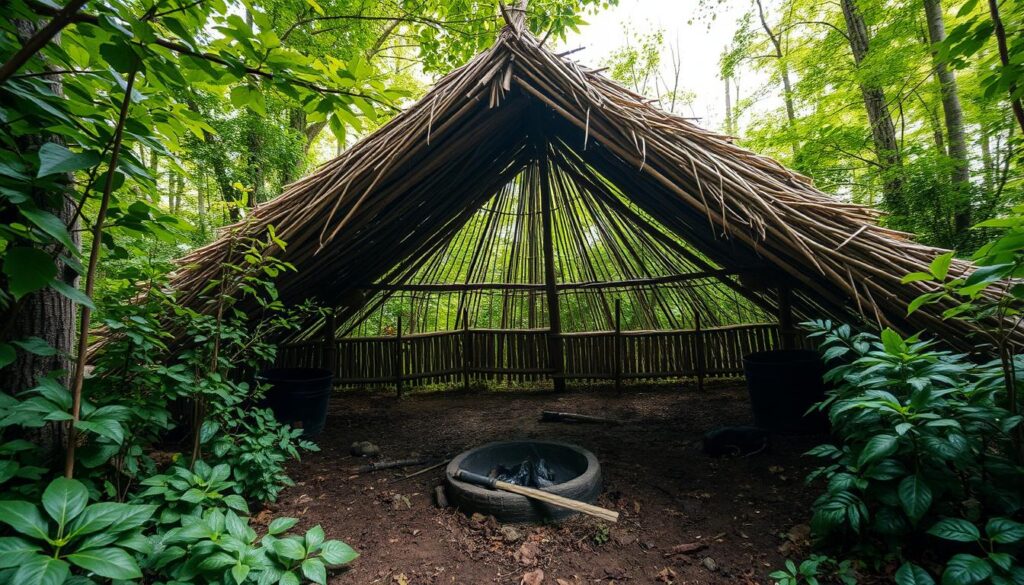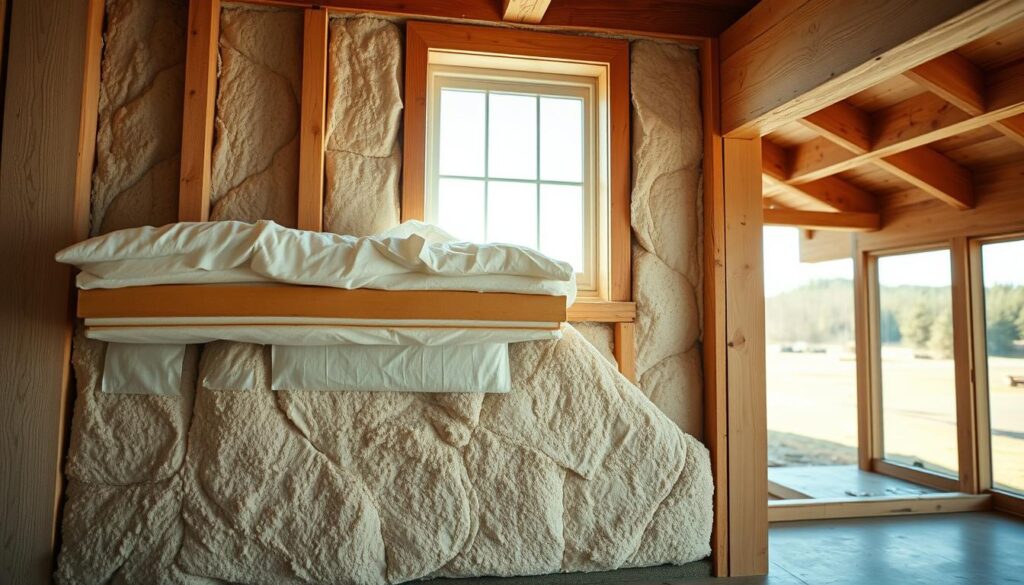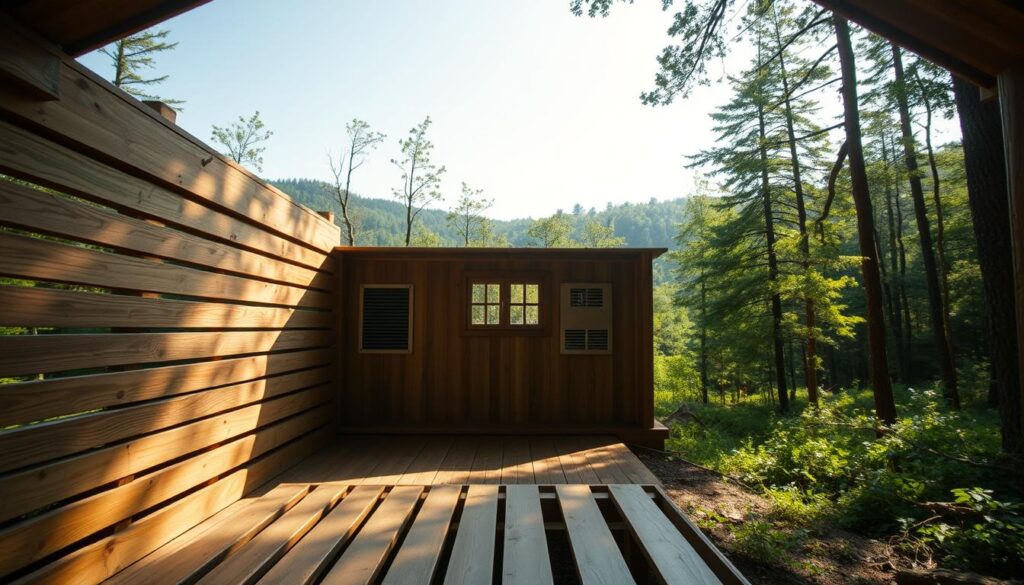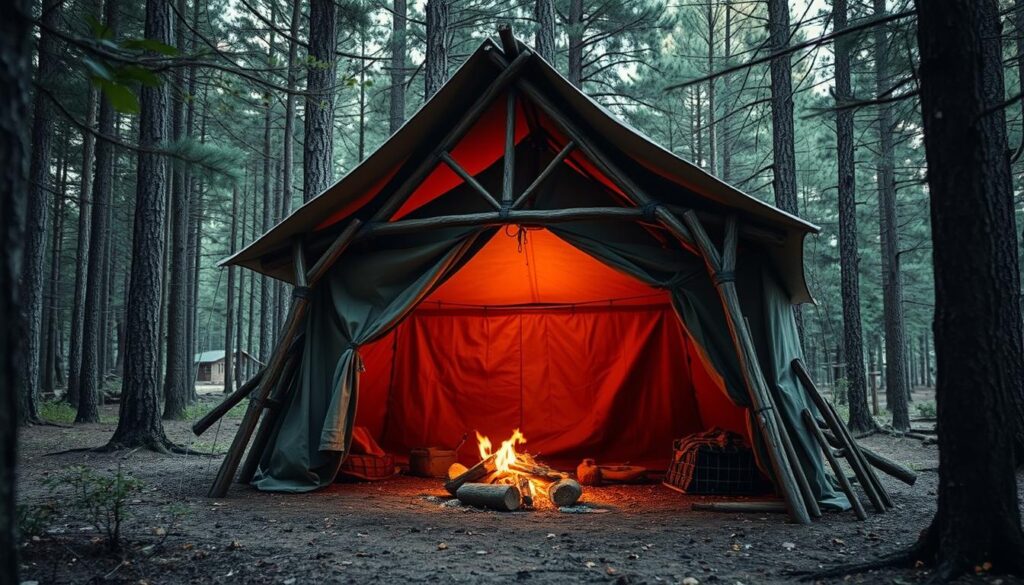When you go into the wilderness, a good shelter can save your life. I know this from my own survival experiences.
In this article, I’ll teach you how to build a shelter easily. We’ll look at different shelters and when to use them in survival situations.
Knowing how to make a DIY shelter is key for anyone exploring the wild. This guide will help you feel ready for any survival challenge.
Key Takeaways
- Understand the importance of shelter in survival situations
- Learn various techniques for constructing a wilderness shelter
- Discover DIY shelter tips for different environments
- Gain confidence in handling unexpected survival situations
- Apply simple, effective shelter construction methods
Introduction to Shelter Building
Building a shelter is key for outdoor survival. It keeps you safe from the weather and wild animals. A good shelter can be a lifesaver.
Creek Stewart, a top survival expert, says shelter is the most important thing in bad weather. He stresses the need to know and use emergency shelter techniques to stay safe and warm in the wild.
Importance of Shelter
Shelter is very important in survival situations. It keeps you safe from rain, snow, wind, and cold. It also gives you a sense of safety and comfort.
A good shelter helps keep you warm and dry. This is key in cold and wet weather to avoid getting sick.
Basic Principles of Shelter
Building a shelter needs some basic rules. First, pick a spot that’s high, dry, and flat. This helps avoid water and keeps you safe from wind and floods.
Choosing the right materials is also key. You can use branches, leaves, and snow. The goal is to find materials that keep you warm and safe. Knowing how to use outdoor survival structures is essential for a good shelter.
Types of Shelters
When you’re in the wilderness, knowing about different shelters is key to survival. Shelters can be temporary or permanent, each with its own purpose. They help you stay safe in various survival situations.
Temporary vs. Permanent Shelters
Temporary shelters give quick protection from the weather. They’re great for emergencies or when you’re moving around. They’re easy to make and need few materials.
Permanent shelters, on the other hand, offer long-term safety and comfort. They take more time, effort, and materials to build.
Temporary Shelters are good for short stays or when you’re not sure where you’ll be. Examples include lean-to shelters, debris huts, and snow shelters. Permanent Shelters are better for longer stays, providing more protection and comfort.
| Shelter Type | Duration | Materials Needed |
|---|---|---|
| Lean-To | Temporary | Branch, leaves, rope |
| Debris Hut | Temporary/Permanent | Sticks, leaves, mud |
| Snow Shelter | Temporary | Snow, digging tool |
Natural Shelters and Their Benefits
Natural shelters use the environment to protect you. Examples are caves, rock overhangs, and hollowed-out logs. They’re great because they save energy and resources.
Natural shelters are quick fixes in survival situations. They offer immediate safety. But, they might not always be safe or available, so be careful.

Constructed Shelter Options
Constructed shelters are made from materials found in nature. They can be simple lean-tos or complex debris huts. The choice depends on the materials, weather, and your skills.
Learning from a wilderness shelter building tutorial can help you build a safe shelter. For beginners, start with simple structures like lean-tos. This will help you move on to more complex ones.
Knowing how to build different shelters can greatly improve your survival chances in the wilderness. Whether you choose a temporary or permanent shelter, pick one that meets your immediate needs and considers your long-term safety.
Choosing a Location
Finding the right spot for your shelter is key. It should offer natural protection, be easy to get to, and have a solid base. This is the first step in building a good outdoor shelter.
Evaluating Terrain and Environment
When picking a spot, think about the terrain and environment. Look for a flat, dry area. Stay away from places with water or where water often gathers. The ground should also be stable, not likely to slide or erode.
Key factors to consider include:
- Proximity to a water source
- Availability of building materials
- Natural protection from wind and sun
- Visibility and accessibility
Considerations for Weather and Safety
Weather and safety are very important when choosing a shelter location. Think about the usual weather and any dangers like floods, storms, or extreme cold.
Some weather-related considerations include:
| Weather Condition | Preferred Location |
|---|---|
| Heavy Rainfall | Elevated areas, away from flood plains |
| Extreme Cold | Sheltered valleys or areas with natural windbreaks |
| High Winds | Low-lying areas or behind natural barriers |
By looking at the terrain, environment, weather, and safety, you can pick a great spot. This will make your shelter better and help you succeed in building a basic shelter.
Essential Tools and Materials
Building a shelter is all about the right tools and materials. Whether you’re experienced or new, the right gear makes a big difference. It helps create a safe and strong shelter.
For DIY shelter tips, having the right tools is key. A good toolkit helps with many tasks. This includes cutting, shaping, and assembling the shelter.
Must-Have Tools for Building Shelters
First, you need some basic tools for your project. These are the foundation of your shelter building. You’ll need:
- A reliable knife or saw for cutting materials
- A hammer or mallet for driving stakes and fitting parts together
- Rope or twine for securing the structure
- A shovel for digging foundations or trenches
Recommended Materials for Durability
Choosing the right materials is also vital for a durable shelter. For a shelter building guide focused on lasting quality, pick materials that resist weather and environmental changes.
Some top picks include:
- Waterproof tarps or plastic sheets for roofing
- Durable woods like cedar or pine for framing
- Metal stakes or anchors for securing the shelter
- Insulating materials like foam or fabric for temperature control
With these tools and materials, you’re set to build a shelter. It will be safe, durable, and comfortable.
Step-by-Step Shelter Construction
Building a shelter is key to surviving in the wilderness. It’s a skill that needs careful planning and doing. I’ll show you how to build a shelter, from planning to finishing it.
Planning and Design Phase
The first step is to plan and design your shelter. You need to think about what you need, the environment, and the materials. Start by:
- Looking at the terrain and weather
- Figuring out how many people will be there and how much space you need
- Picking materials that are strong and easy to find
Foundation and Framework Building
After planning, it’s time to build the foundation and framework. This means:
- Cleaning the area and getting it ready
- Building the base with strong stuff like logs or rocks
- Creating the structure with branches or poles
A solid base and structure are key for a strong shelter.
Adding Walls and Roof
Now, add walls and a roof to your shelter. You’ll need to:
- Use natural stuff like leaves, grasses, or snow for walls
- Make a roof that’s waterproof and strong
- Make sure your shelter has good air flow and protects from the weather
By following these steps, you can make a shelter that’s safe and comfy in the wilderness.
Building a shelter takes practice and patience. With these makeshift shelter instructions, you can learn to build a shelter when you need to.
Insulation Techniques
A well-insulated shelter is key for survival in tough weather. It keeps you warm and cozy, shielding you from cold or heat.
Common Insulation Materials
Choosing the right insulation material is important. You can use natural fibers like wool, cotton, and down feathers. Or synthetic materials like foam and fiberglass.
Natural fibers are good because they breathe and are eco-friendly. But they might not keep you as warm as synthetic materials.
| Material | Insulation Effectiveness | Moisture Resistance |
|---|---|---|
| Wool | High | Moderate |
| Cotton | Moderate | Low |
| Foam | High | High |
| Fiberglass | High | Moderate |
How to Insulate Your Shelter
To insulate your shelter well, plan carefully. Look for gaps around doors and windows where heat escapes.
For more on building survival shelters, check out BeaverCraft Tools. They offer tips on emergency shelter techniques and basic shelter construction guide.

By picking the right insulation and using smart techniques, you can make your shelter more comfortable and safe.
Creating a Waterproof Shelter
Waterproofing your shelter is key to staying safe. It’s vital when you’re in the wilderness or facing emergencies. A shelter that keeps you dry is essential.
Importance of Waterproofing
A waterproof shelter keeps you dry and comfy. Water can cause hypothermia and damage your gear. It’s important for survival, as I explain in my guide to making a reliable survival shelter, effective shelter building is critical.
Survival experts say a non-waterproof shelter is dangerous. It exposes you to harsh weather. Making sure your shelter is waterproof is a safety must.
Methods to Prevent Water Damage
There are ways to stop water damage. Here are some good methods:
- Use waterproof materials for the roof and walls.
- Apply a waterproof coating or sealant to all seams and joints.
- Ensure the shelter is pitched correctly to allow water to run off.
- Use a tarp or plastic sheeting to provide an extra layer of protection.
Let’s look at waterproofing materials:
| Material | Water Resistance | Durability |
|---|---|---|
| Polyurethane-coated nylon | High | High |
| Silicone-coated fabric | High | Medium |
| PVC-coated polyester | Medium | High |
Different materials have different water resistance and durability. Picking the right one is important for your shelter’s waterproofing.
Understanding waterproofing and using the right methods keeps your shelter safe and dry. This is true in any weather.
Ventilation Considerations
When building a wilderness shelter, ventilation is key. It keeps the shelter healthy and comfortable.

Importance of Airflow
Airflow is vital for several reasons. It removes moisture, preventing mold and mildew. It also brings in fresh air, keeping occupants healthy and comfortable.
Without enough airflow, the shelter’s air can become stale and humid. This can cause discomfort and serious health problems. Good ventilation balances the shelter’s air with the outside environment.
Best Practices for Ventilation
To ensure good ventilation, follow these tips:
- Make sure your shelter has enough openings for air to flow in and out.
- Choose materials that let air pass through, like breathable fabrics or spaced logs.
- Place your shelter where natural airflow is best, like near a ridge or on a slope.
- Think about the wind direction when designing your shelter’s ventilation.
By using these methods, you can make a well-ventilated shelter. It will be a healthy and comfy place, even in tough wilderness areas. Understanding ventilation is essential for a successful shelter, as part of a wilderness shelter building tutorial or shelter building guide.
Interior Design and Layout
Designing a shelter’s interior is as key as building it. It affects how comfortable and livable the space is. A well-designed interior can make the shelter more functional and comfortable.
When designing the interior, think about what the occupants need. In a makeshift shelter, focus on function over looks. Make sure the space is laid out to fit the essentials and is easy to move around in.
Space Utilization in Shelter
Using space wisely is vital in shelter design. Use furniture and storage that does more than one thing. For example, a storage ottoman can be a seat and a place to store things.
| Space-Saving Solution | Description | Benefit |
|---|---|---|
| Multi-functional Furniture | Furniture that serves more than one purpose, such as a sofa bed. | Maximizes floor space |
| Vertical Storage | Using wall-mounted shelves and storage units. | Reduces clutter and keeps floor clear |
| Foldable Items | Items like foldable tables and chairs that can be easily stored. | Enhances flexibility in space usage |
A
study on shelter design found that using space well makes a shelter feel bigger and more comfortable
. This shows how important good interior design is in building shelters.
Creating Comfort and Functionality
Creating a cozy and useful interior is more than just saving space. It’s also about making the space feel welcoming. Adding natural light, good air flow, and comfy furniture can make a big difference.
For a basic shelter construction guide, include tips on making the space cozy. Use the right lighting, comfy bedding, and personal touches to make it feel like home.
By focusing on both saving space and comfort, you can make a shelter that’s both useful and pleasant. This approach follows makeshift shelter instructions that focus on both immediate needs and long-term comfort.
Safety Measures and Precautions
Safety is key when building a shelter. It affects the health and well-being of those inside. When making an emergency shelter, think about what could make it unstable or unsafe.
Assessing Structural Integrity
First, check if the shelter is strong. Look at the materials, design, and how well it’s built. For outdoor survival structures, think about wind, flooding, and snow weight.
Fire Safety in Shelters
Fire safety is also vital. Make sure the shelter can’t catch fire easily. Also, have a plan for getting out quickly if there’s a fire. Use materials that don’t burn well and have a clear escape route.
By paying attention to these safety steps, people can make their outdoor survival structures safer. This makes living in shelters less risky.
Maintenance and Upkeep
Building a shelter is a big job. But keeping it in good shape is just as important. This is true, whether you’re in the wilderness or somewhere else tough.
Routine Checks
It’s smart to check your shelter often. Look for damage or wear, like after bad weather. This helps catch problems early.
Long-term Sustainability
Think about how long your shelter will last. Choose materials that are strong and don’t harm the environment. This way, your shelter will stay safe and reliable for a long time.
By following these tips, your shelter will stay a safe place. It will give you protection and comfort when you need it.
FAQ
What is the most important factor to consider when choosing a location for my shelter?
When picking a spot for your shelter, look at the terrain and environment. Think about how close it is to water, natural hazards, and how easy it is to get to.
What type of shelter is best suited for a survival situation?
In survival situations, a temporary shelter like a lean-to or debris hut is best. They’re easy to make and provide quick protection.
What are the essential tools needed for building a shelter?
You’ll need a knife, saw, rope, and hammer to build a shelter. These tools help you gather materials, build the frame, and secure it.
How can I ensure my shelter is waterproof?
To make your shelter waterproof, use tarps, plastic sheets, or waterproof membranes. Cover the roof and walls well to prevent water from getting in.
What are some common insulation materials used in shelter building?
Insulation can be natural, like leaves and grasses, or synthetic, like foam and reflective materials. Both help keep your shelter warm or cool.
Why is ventilation important in shelter building?
Ventilation keeps air moving, stops moisture buildup, and prevents carbon monoxide poisoning. It makes your shelter healthy and comfortable.
How can I assess the structural integrity of my shelter?
Check your shelter’s foundation, framework, and walls for damage. Make repairs as needed to keep it stable and safe.
What are some best practices for maintaining my shelter?
Regularly check and fix your shelter. Keep it clean and dry. Do routine checks on the structure and materials for long-term use.
How can I create a comfortable and functional interior space in my shelter?
Use space wisely and add bedding and furniture for comfort. Include storage solutions to keep important items handy.
What fire safety precautions should I take in my shelter?
Keep a fire extinguisher or sand nearby. Ensure good ventilation and keep flammable materials away from heat.
What are some DIY shelter tips for wilderness survival?
Use natural materials and build a lean-to or debris hut. Add insulation and ventilation for a safe, cozy shelter.
How can I make my shelter more durable?
Use strong materials, build a solid framework, and do regular maintenance. This helps your shelter last through harsh weather.



